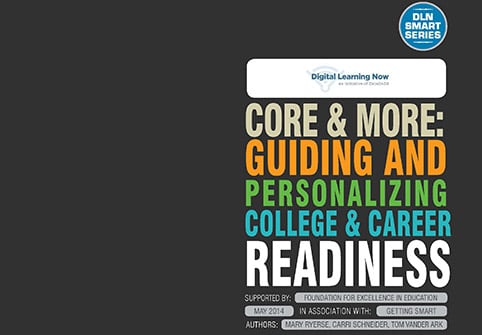Guiding and Personalizing College & Career Readiness

By: Mary Ryerse and Tom Vander Ark
As families and communities gather to watch students walk across the stage in cap and gown to receive a high school diploma, it is often a time of great celebration. Sadly, according to anew analysis from the NAEP governing board , fewer than 40% of of seniors are prepared for college. Further, many graduate without a clear plan for college or career-ready skills.
At this time when academic expectations are high and college and career options are many, varied, and constantly changing, students need new levels and types of support. High school graduation could hold more cause for celebration if every secondary student were provided with tools and systems that helped them successfully meet standards and prepare for the transition to college and career. What if all schools systematically guided all students by helping them think about who they are, where they are headed and how they will get there?
Today Getting Smart released the 11th paper in the DLN Smart Series with Digital Learning Now (DLN) that addresses this topic. “Core & More: Guiding and Personalizing College & Career Readiness” brings together regular Smart Series authors Carri Schneider and Tom Vander Ark with co-author Mary Ryerse, college and career readiness expert.
This paper outlines how a blended, distributed and scheduled student guidance process can help students meet academic expectations and choose from the ballooning educational options available to them today. We have a perfect opportunity to further personalize the guidance process itself by providing more robust supports to foster individual student success through relationships and tools that focus on the three elements described in Getting Smart:
- Motivation – building sustained relationships with students, exploring areas of interest and related careers, addressing barriers to school attendance;
- Customization – helping students set short and long term goals, track progress, and experience success in class, in job settings, and in community services;
- Equalization – broadening exposure to college and career options, providing high touch/high tech decision support for postsecondary planning for all students.
The paper outlines ten recommended functions of student guidance which build upon the work of David Conley, author of “Getting Ready for College, Careers, and the Common Core” and founder of the Education Policy and Improvement. Conley’s four readiness keys include cognitive strategies (THINK), content knowledge (KNOW), learning skills and techniques (ACT), and transition of knowledge and skills (GO). In order to fulfill these keys, we believe that students need their schools to systemize these guidance functions:
1. Academic Mindset and Culture
2. Understanding Assessments
3. Academic Monitoring
4. Homework Help
5. Course Selection and Transcript Management
6. Self-Management
7. Social and Emotional Learning
8. College Guidance
9. Career Guidance
10. Individual Counseling and Referrals
At the core of these systems is a culture of with high expectations, high support and strong relationships. NASSP’s 2013 Principal of the Year, Trevor Greene made establishing such a culture a high priority at Toppenish High School (Washington), which serves a high minority (95%) and high poverty (100%) population. In just two years, he raised the grad rate from 84.6% to 98.3%.Greene gives credit to the student guidance offered through advisory, “I attribute our graduation rate increase directly to what we’ve been doing in our advisory. I’m a true believer.”
With robust blended, distributed and scheduling processes, not only can more students walk across the graduation stage with a diploma, but also with strong academic preparation and a meaningful plan to go with it.
To learn more or to download the full paper and infographic, go to digitallearningnow.com/dln-smart-series or follow along on social media using the hashtags #SmartSeries, #CCR and #DigLN.
Digital Learning Now is a Getting Smart Advocacy Partner.



0 Comments
Leave a Comment
Your email address will not be published. All fields are required.